Making vanilla macarons with my recipe creates perfectly delicious macarons whether you are a beginner or an expert baker. They feature sweet vanilla buttercream that has been sandwiched between two light and airy vanilla shells. No matter the occasion, macarons are a special treat that everyone will enjoy.
See my post dedicated to macaron flavors for more fun, delicious combinations, or my mummy macarons for Halloween.
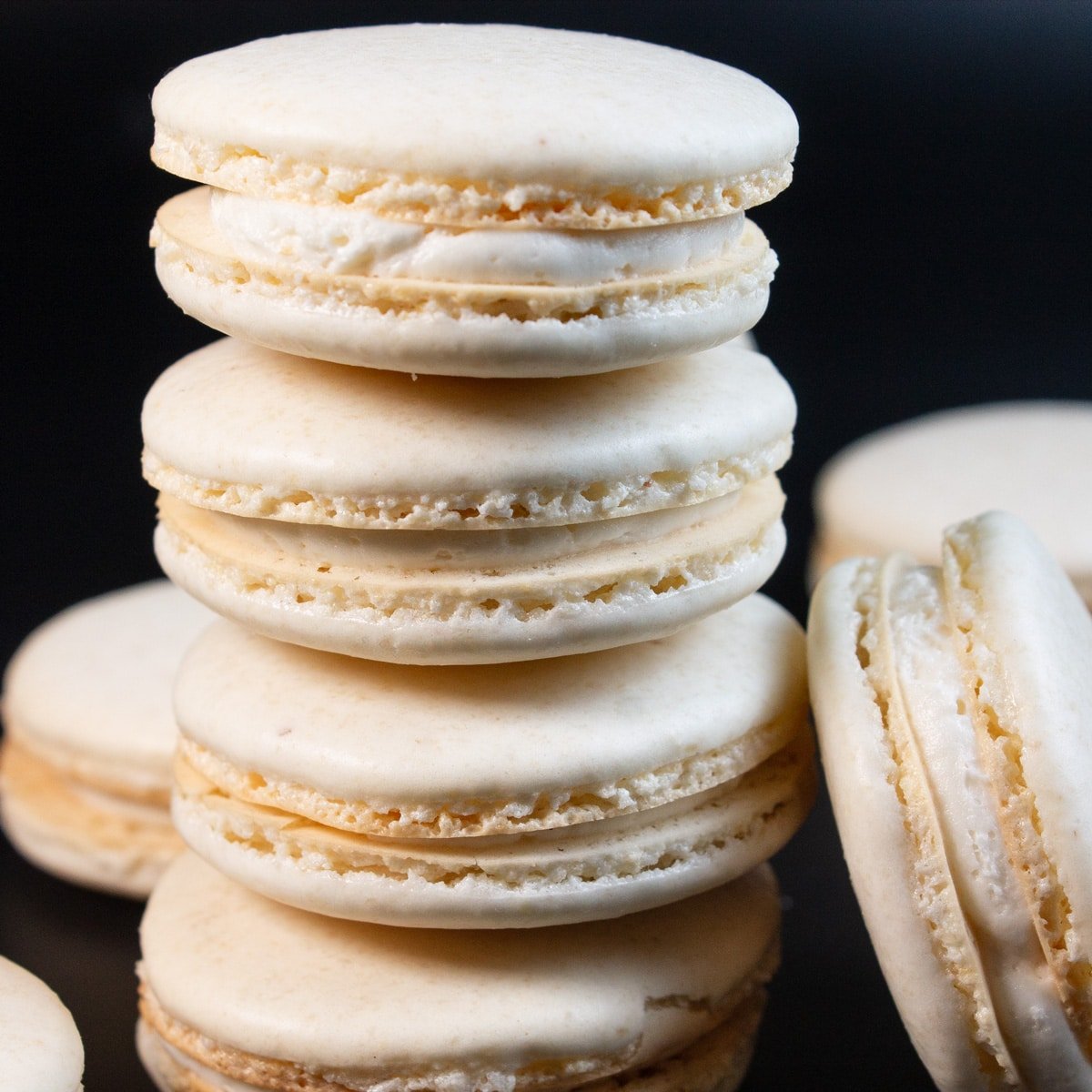
Jump to:
Macarons have a bad stigma that they are incredibly difficult to make. While I admit that these cookies can be pretty technical, they aren't hard to make once you get started.
The key to perfect macarons is following every step exactly (as well as weighing your ingredients). As long as you don't make substitutions or take shortcuts, I know your macarons can turn out great!
This recipe also makes a wonderful base recipe for many different types of macaron flavor combinations. Experiment by swapping the vanilla extract for different flavored extracts or using different fillings.
🥘 Ingredients

Macarons
- Almond Flour - Almond flour is the key ingredient for making macaron shells. Make sure you grab almond flour and not almond meal. For proper macarons, you cannot substitute this.
- Powdered Sugar - Some simple confectioners sugar for sweetness.
- Egg Whites - I strongly recommend using fresh egg whites, and not ones from a carton.
- Vanilla Extract - This will give your shells a vanilla flavor. If you want, you can easily change the flavor of these macarons by using a different extract (like almond or coconut).
- Cream of Tartar - A small amount of cream of tartar helps to stabilize your meringue.
- Sugar - Granulated white sugar aka table sugar.
Vanilla Buttercream
- Butter - Unsalted butter that is at room temperature.
- Confectioners Sugar - This is what sweetens and thickens your buttercream.
- Vanilla Extract - Some vanilla will give your buttercream flavor.
- Heavy Cream - A small amount of heavy cream will thin your buttercream to your desired consistency.
- Salt (optional) - Adding salt, to taste, will reduce the sweetness of any buttercream frosting recipe.
Note on Weighing Ingredients
Weighing all of your ingredients is the best way to ensure that you have the most accurate measurements possible (which truly matters in macarons). After all, baking is a science!
If you don't have a kitchen scale or simply don't want to mess with measurements, use the following amounts:
- 1¼ cup + 2 teaspoon almond flour
- 1¼ cup + 1 teaspoon confectioners sugar
- ⅓ cup + 1 teaspoon sugar
- 3-4 large egg whites (sometimes I need exactly 3 egg whites and sometimes I need just a little more, depending on the eggs)
- ½ tsp vanilla extract
- ¼ tsp cream of tartar
Be sure to see the free printable recipe card below for ingredients, exact amounts & instructions with tips!
🔪 How To Make Vanilla Macarons
I will admit that there are a lot of steps to making macarons, but it isn't difficult to do. If your macarons don't work out, you can always try again!
You will need a stand mixer or hand mixer, some glass or metal mixing bowls, a kitchen scale, a silicone spatula, a baking sheet, and a piping bag. Make a macaron template or use the silicone baking mats that have round outlines for perfect shell shapes.
This recipe will make 40 macaron shells or 20 fully assembled macarons.
Make the Macaron Batter
Step 1: Add the dry ingredients. In the bowl of your food processor, add 125 grams of almond flour (1¼ cup + 2 teaspoons) and 125 grams of confectioners sugar (1¼ cup + 1 teaspoon).


Step 2: Sift. Blend with the food processor on low speed until the mixture has become extra-fine. Then, use a fine-mesh sieve to sift the mixture into a large mixing bowl. Set aside.
Step 3: Begin the meringue. In a separate large mixing bowl, use a hand mixer or stand mixer with the whisk attachment to beat 100 grams of egg whites (3-4 large egg whites), ½ teaspoon of vanilla extract, and ¼ teaspoon of cream of tartar until soft peaks form.
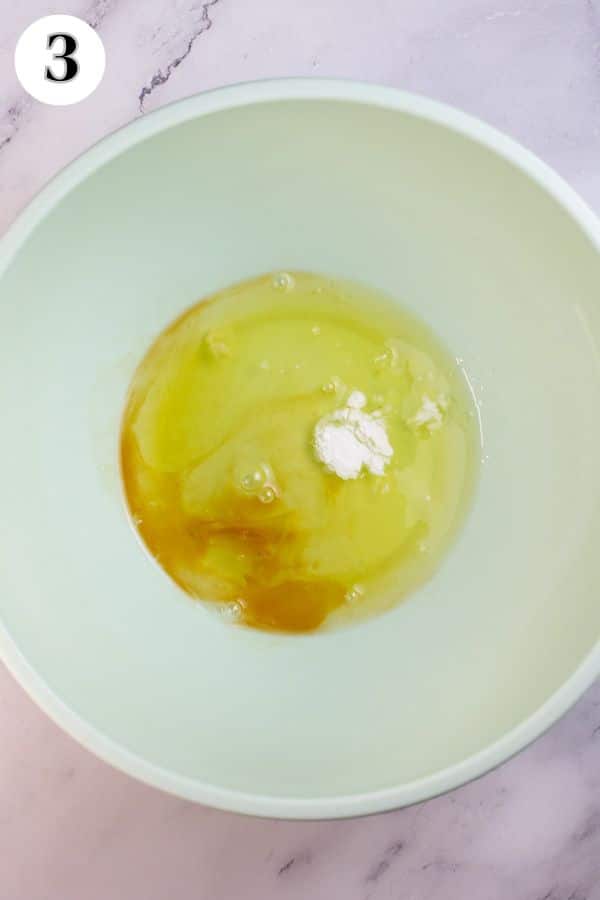
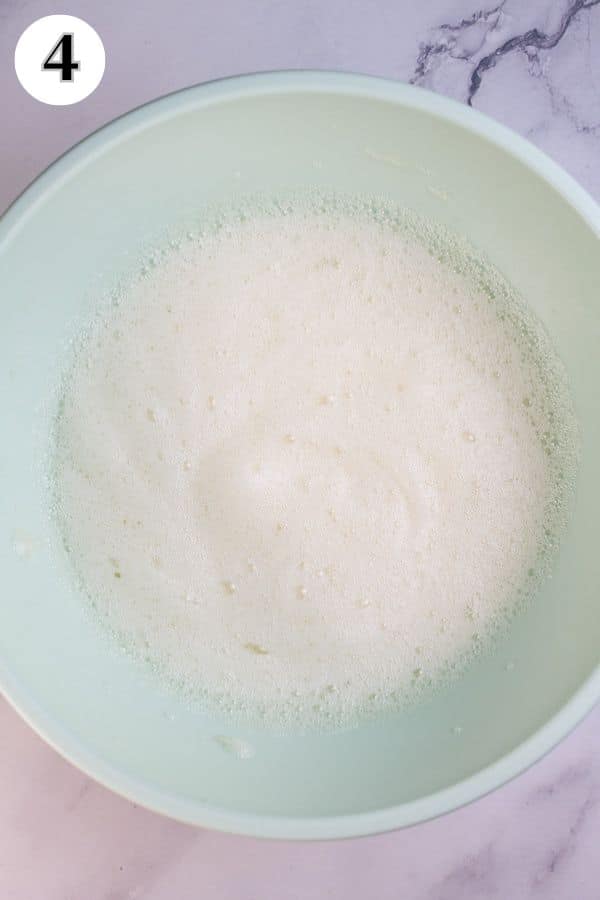
The egg mixture will start out looking foamy and will have soft peaks once the whisk begins to leave tracks.
Step 4: Incorporate the sugar. Gradually add 80 grams (⅓ cup + 1 teaspoon) of sugar to the egg whites while continuing to mix, until everything is fully distributed.
Step 5: Finish beating. Continue to beat the egg mixture until stiff peaks form.

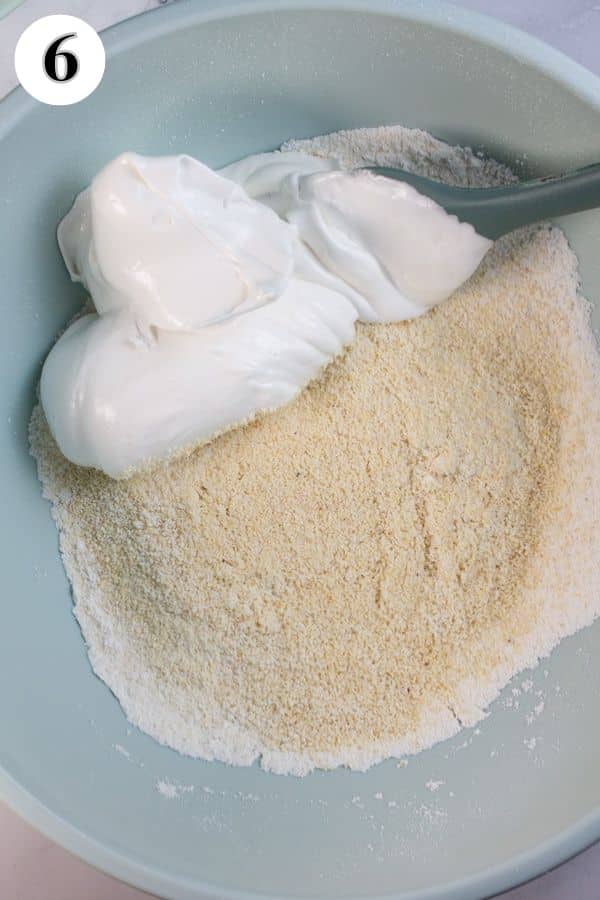
Step 6: Begin folding. Scoop ⅓ of the whipped egg mixture into your flour mixture and use a rubber spatula to gently fold it in until it is combined.
Step 7: Finish adding. Repeat this process with the remaining ⅔ of the egg whites, only adding ⅓ at a time, and gently folding in between each addition.
Step 8: Get the right consistency. After the last bit of the flour mixture has been added, continue to gently and slowly fold the macaron batter until the batter falls from the spatula in ribbons. *The consistency should be similar to honey or lava. If you let the batter fall from your spatula, it should only take about 10 seconds to sink back into itself.
Top Tip: Macaron Batter Consistency
One of the biggest mistakes bakers make with macarons is not combining the batter until it reaches the right consistency (this is called macaronage).
When you first start folding, the mixture will be very thick. As you continue to fold, it will become thinner.
The ideal consistency will move similarly to lava and will fall off your spatula in ribbons. It should also be shiny.
An easy way to test if it is ready is to form a figure 8 with the batter as it falls off of your spatula. It should take about 10 seconds for the batter to sink back into itself.
If it takes longer, your batter is too thick and needs to be folded some more. If it happens more quickly, your batter is too thin and has been overmixed.
Overmixed batter can't be fixed, and it will cause your shells to crack or not develop feet. Undermixed batter will cause lumpy and hollow shells. Go slow to avoid accidentally overmixing it.
Pipe the Macarons
Step 9: Transfer. Once you have reached the perfect consistency, transfer the batter into a piping bag that has been fitted with a round tip (or a storage bag with the corner cut off).

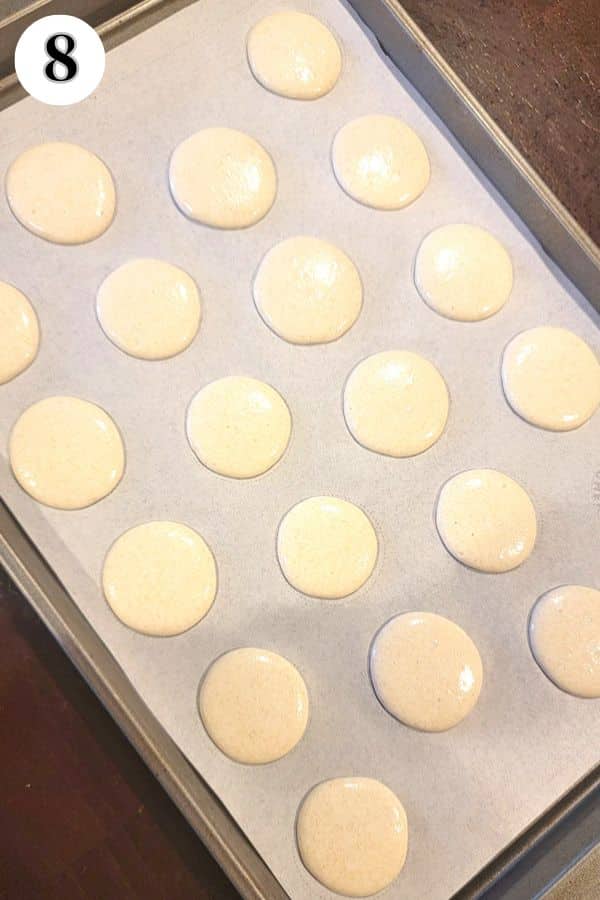
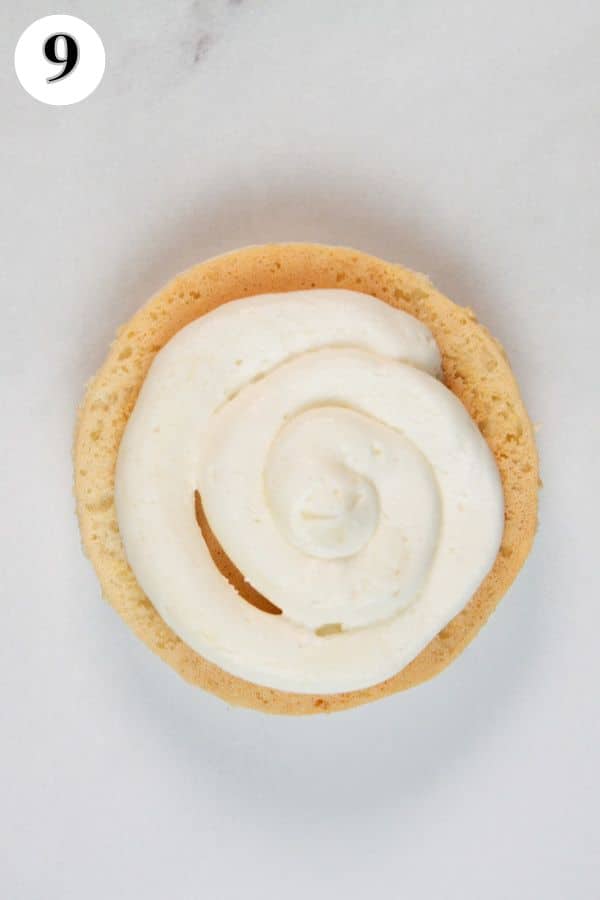
Step 10: Prepare your baking sheet. If you have a macaron mat, place it onto your rimmed baking sheet. However, if you don't have one, place a dot of batter into each corner of your rimmed baking sheet and place a piece of parchment paper on top (the batter acts as a glue to keep the paper from sliding around).
Step 11: Pipe. Pipe the macarons onto your parchment paper (or mat) in 1½-inch circles, making sure to space them at least ½-inch apart from each other.
Step 12: Remove air bubbles. Firmly tap the baking sheet on the counter 5 times to get rid of any air bubbles. Then, use a toothpick to pop any remaining bubbles that you might see.
Step 13: Rest. Allow the macarons to rest on the counter at room temperature for 30-60 minutes, or until they are dry to the touch and no longer tacky.
Step 14: Preheat. While the macarons are resting, go ahead and preheat your oven to 325˚F (160˚C/Gas Mark 3).
Step 15: Bake. Once ready, bake the macarons for 10-13 minutes, or until the macarons don't move if you tap on them slightly (they should be only just starting to brown).
Step 16: Cool. Remove the macarons from the oven and let them cool on your baking sheet for 10 minutes before transferring them to a wire rack to finish cooling.
How To Pipe Macarons
Piping macarons is easy to do. You can use a large round piping tip (which is easier) or just a storage bag with the corner cut off.
Hold your piping bag about ¼-inch above the mat or parchment paper at a 90° angle. Squeeze the bag to pipe the batter into the center of the circle until it reaches the inner circle on your template.
Stop squeezing and lift the bag straight up or in a little c-shape to break the batter off. Then, move on to the next circle.
The batter will flatten out in a few seconds.
Make the Vanilla Buttercream (optional)
Step 17: Mix butter. In a large mixing bowl, add ½ cup (113.5 grams) of room temperature butter. I recommend butter that is between 68-70°F (20-21°C), and not so soft that you can easily indent it with your fingertip.
Use a hand mixer or stand mixer to beat it for 1 minute until the butter has become light and fluffy.
Step 18: Add sugar. Using a fine-mesh sieve, sift in 1 cup (120 grams) of confectioners' sugar and mix until thoroughly incorporated.
Step 19: Mix. Next, add ½ teaspoon of vanilla extract and beat to combine. Gradually add ½ tablespoon of heavy cream in small increments, making sure to beat in between each addition until you reach your desired consistency.
Assemble the Macarons
Step 20: Scoop. Scoop the buttercream into a piping bag with a round tip (or a storage bag with the corner cut off).
Step 21: Add filling. Take one cooled macaron shell and pipe some buttercream into the center. Place a second macaron shell on top and gently press them together, forming a sandwich.
Step 22: Repeat. Repeat this process with your remaining macaron shells and vanilla buttercream.
Step 23: Chill or serve. For best results, place the macarons into an airtight container in the fridge for 24 hours. Then, allow them to come up to room temperature and serve.
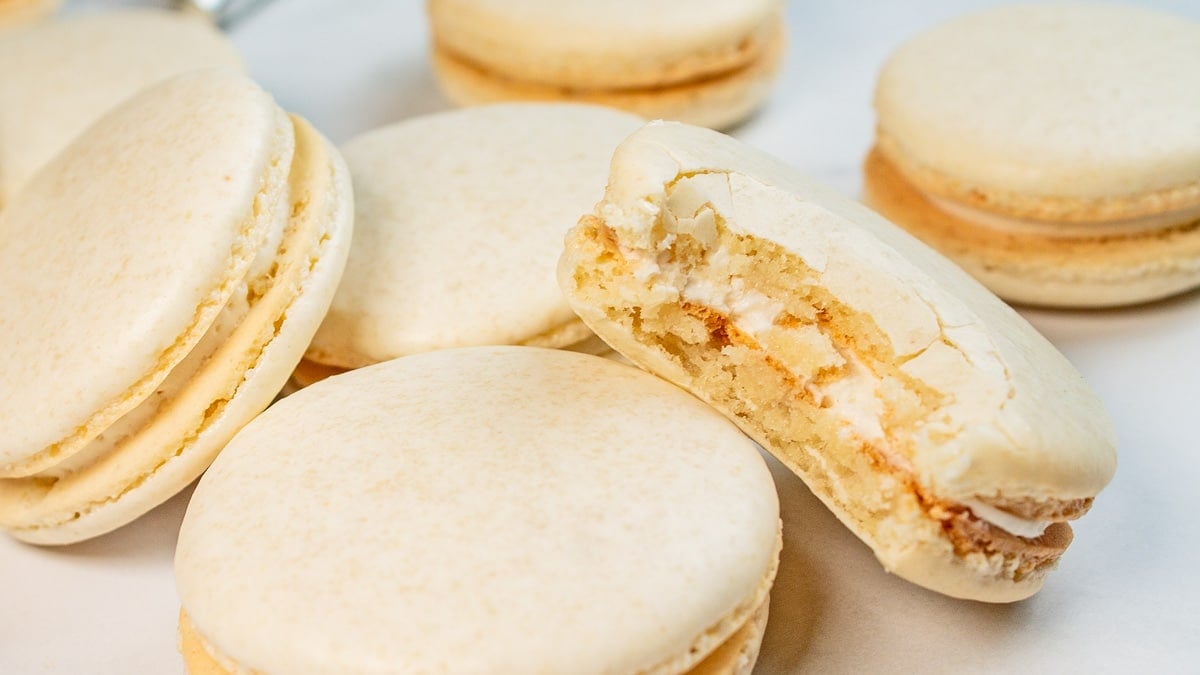
>>>See All Of My Tasty Recipes Here!<<<
💭 Angela's Pro Tips & Recipe Notes
- Use your favorite filling. I used vanilla buttercream for my macarons, but you can use any filling you like. Try them with different frosting flavors, jelly, or ganache.
- Reach stiff peaks. It is important that you beat the egg mixture until stiff peaks form, not stopping before that. If you aren't sure if the mixture is thick enough, hypothetically, you should be able to flip the bowl upside down and nothing should fall out.
- Use a piping tip. While you can use a storage bag with the tip cut off, it is easier to be more precise with a piping bag and tip. I used a Wilton 12 tip for both the macarons and the buttercream.
- Try a template. Macaron baking mats make piping macarons much easier, as they ensure they are all the perfect size. However, if you don't have a mat, you can always print out a template, trace circles onto parchment paper, or buy parchment paper that has the template already on it.
- Use room-temperature eggs. Make sure that any of your refrigerated ingredients (such as eggs) have come to room temperature before using.
- Sift the ingredients. Don't skip out on sifting your ingredients. This is what helps to achieve the perfect texture.
- Let them rest. Let your macarons rest for 30-60 minutes before putting them in the oven. This allows them to form the feet and is a crucial part of the process. They should be dry and no longer tacky.
- Remove air bubbles. Air bubbles will cause your macarons to crack. After piping them, firmly bang the baking sheet onto the counter to pop the air bubbles. Then, use a toothpick to pop any that you can still see.
📚 Looking for More Macaron Resources?
See the complete beginner's guide to making macarons for starting your journey to macaron mastery. Or get help with the baking process in my troubleshooting macarons article.

How Do I Color My Macarons?
This recipe is perfect for adding colors. You can use them for baby showers, holidays, parties, or any other festivities.
If you want to color your macarons, it is important that you use gel food coloring and not liquid food coloring. The liquid can throw off the balance in the batter.
Add your gel color to your egg whites when they have almost reached stiff peaks, then continue beating as normal. For multiple colors, divide the whipped egg whites into separate bowls.
🥡 Storing
Place shells into an airtight container and refrigerate for up to 6 days. Simply add your filling when you are ready.
If assembled, place your macarons into the fridge in an airtight container for up to 4 days.
Freezing
Once the shells have fully cooled, place them into an airtight container and freeze them. When ready, allow them to thaw in the fridge for a few hours before filling and assembling them.
You can also freeze fully assembled macarons. Allow your macarons to fully bloom in the fridge for 24 hours before freezing them.
Stack them carefully in an airtight container and place them in the freezer. When ready, allow the macarons to thaw in the fridge for a few hours.

Do you love a recipe you tried? Please leave a 5-star 🌟rating in the recipe card below and/or a review in the comments section further down the page.
Stay in touch with me through social media @ Pinterest, Facebook, Instagram, or Twitter! Subscribe to the newsletter today (no spam, I promise)! Don't forget to tag me when you try one of my recipes!
📖 Recipe Card
Vanilla Macarons
Ingredients
Vanilla Macarons
- 125 grams almond flour (about 1¼ cup + 2 tsp)
- 125 grams confectioners sugar (about 1¼ cup + 1 tsp)
- 100 grams egg whites (about 3-4 large eggs, room temperature)
- ½ teaspoon vanilla extract
- ¼ teaspoon cream of tartar
- 80 grams sugar (about ⅓ cup + 1 tsp)
Vanilla Buttercream (optional)
- ½ cup butter (unsalted)
- 1 cup confectioners sugar
- ½ teaspoon vanilla extract
- ½ tablespoon heavy cream (or more, if needed)
(Note: 2x or 3x only changes the ingredient list)
Instructions
Make The Macarons
- In the bowl of your food processor, add the 125 grams almond flour and 125 grams confectioners sugar.
- Blend with the food processor on low speed until the mixture has become extra-fine. Then, use a fine-mesh sieve to sift the mixture into a large mixing bowl. Set aside.
- In a separate large mixing bowl, use a hand mixer or stand mixer with the whisk attachment to beat the 100 grams egg whites, ½ teaspoon vanilla extract, and ¼ teaspoon cream of tartar until soft peaks form. The egg mixture will start out foamy and will have soft peaks once the whisk begins to leave tracks.
- Gradually add 80 grams sugar to the egg whites while continuing to mix, until everything is fully distributed.
- Continue to beat the egg mixture until stiff peaks form.
- Scoop ⅓ of the whipped egg mixture into your flour mixture and use a rubber spatula to gently fold it in until it is combined.
- Repeat this process with the remaining ⅔ of the egg whites, only adding ⅓ at a time, and gently folding in between each addition.
- After the last bit of the egg mixture has been added, continue to gently and slowly fold the macaron batter until the batter falls from the spatula in ribbons. *The consistency should be similar to honey or lava. If you let the batter fall from your spatula, it should only take about 10 seconds to sink back into itself.
Pipe The Macarons
- Once you have reached the perfect consistency, transfer the batter into a piping bag that has been fitted with a round tip (or a storage bag with the corner cut off).
- If you have a macaron mat, place it onto your rimmed baking sheet. However, if you don't have one, place a dot of batter into each corner of your rimmed baking sheet and place a piece of parchment paper on top (the batter acts as glue to keep the paper from sliding around).
- Pipe the macarons onto your parchment paper (or mat) in 1½-inch circles, making sure to space them at least ½-inch apart from each other.
- Firmly tap the baking sheet on the counter 5 times to get rid of any air bubbles. Then, use a toothpick to pop any remaining bubbles that you might see.
- Allow the macarons to rest on the counter at room temperature for 30-60 minutes, or until they are dry to the touch and no longer tacky.
- While the macarons are resting, go ahead and preheat your oven to 325˚F (160˚C/Gas Mark 3).
- Once ready, bake the macarons for 10-13 minutes, or until the macarons don't move if you tap on them slightly (they should be only just starting to brown).
- Remove the macarons from the oven and let them cool on the baking sheet for 10 minutes before moving them to a wire rack to finish cooling.
Make The Vanilla Buttercream Filling (optional)
- In a large mixing bowl, add ½ cup butter. I recommend butter that is between 68-70°F (20-21°C), and not so soft that you can easily indent it with your fingertip.
- Use a hand mixer or stand mixer to beat it for 1 minute until the butter has become light and fluffy.
- Using a fine-mesh sieve, sift in 1 cup confectioners sugar and mix until thoroughly incorporated.
- Next, add ½ teaspoon vanilla extract and beat to combine. Gradually add ½ tablespoon heavy cream in small increments, making sure to beat in between each addition until you reach your desired consistency.
Assemble The Macarons
- Scoop the buttercream into a piping bag with a round tip (or a storage bag with the corner cut off).
- Take one cooled macaron shell and pipe some buttercream into the center. Place a second macaron shell on top and gently press them together, forming a sandwich.
- Repeat this process with your remaining macaron shells and vanilla buttercream.
- For best results, place the macarons into an airtight container in the fridge for 24 hours. Then, allow them to come up to room temperature and serve.
Notes
- I used vanilla buttercream for my macarons, but you can use any filling you like. Try them with different frosting flavors, jelly, or ganache.
- It is important that you beat the egg mixture until stiff peaks form, not stopping before that. If you aren't sure if the mixture is thick enough, hypothetically, you should be able to flip the bowl upside down and nothing should fall out.
- While you can use a storage bag with the tip cut off, it is easier to be more precise with a piping bag and tip. I used a Wilton 12 tip for both the macarons and the buttercream.
- Macaron baking mats make piping macarons much easier, as it ensures they are all the perfect size. However, if you don't have a mat, you can always print out a template, trace circles onto parchment paper, or buy parchment paper that has the template already on it.
- Make sure that any of your refrigerated ingredients (such as eggs) have come to room temperature before using.
- Weighing all of your ingredients is the best way to ensure that you have the most accurate measurements possible (which truly matters in macarons). After all, baking is a science!
- If you don't have a kitchen scale or simply don't want to mess with measurements, use the following amounts:
- 1¼ cup + 2 teaspoon almond flour
- 1¼ cup + 1 teaspoon confectioners sugar
- ⅓ cup + 1 teaspoon sugar
- 3-4 large egg whites (sometimes I need exactly 3 egg whites, sometimes I need just a little more, depending on the eggs)
- ½ tsp vanilla extract
- ¼ teaspoon cream of tartar
- Don't skip out on sifting your ingredients. This is what helps to achieve the perfect texture.
- Make sure you don't overmix your batter, as it will cause your macarons to flatten out. The consistency should be thin enough to let the batter fall from your spatula in a figure 8, and it should sink back into itself within about 10 seconds. If it is faster than this, you have overmixed it. If it is slower than this, keep folding to thin it out some more.
- Let your macarons rest for 30-60 minutes before putting them in the oven. This allows them to form the feet and is a crucial part of the process. They should be dry and no longer tacky.
- Air bubbles will cause your macarons to crack. After piping them, firmly bang the baking sheet onto the counter to pop the air bubbles. Then, use a toothpick to pop any that you can still see.
- Place shells into an airtight container and refrigerate for up to 6 days. Simply add your filling when you are ready.
- If assembled, place your macarons into the fridge in an airtight container for up to 4 days.
- To freeze macaron shells: Once the shells have fully cooled, place them into an airtight container and freeze them. When ready, allow them to thaw in the fridge for a few hours before filling and assembling them.
- To freeze assembled macarons: Allow your macarons to fully bloom in the fridge for 24 hours before freezing them. Stack them carefully in an airtight container and place them in the freezer. When ready, allow the macarons to thaw in the fridge for a few hours.


